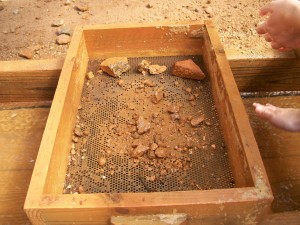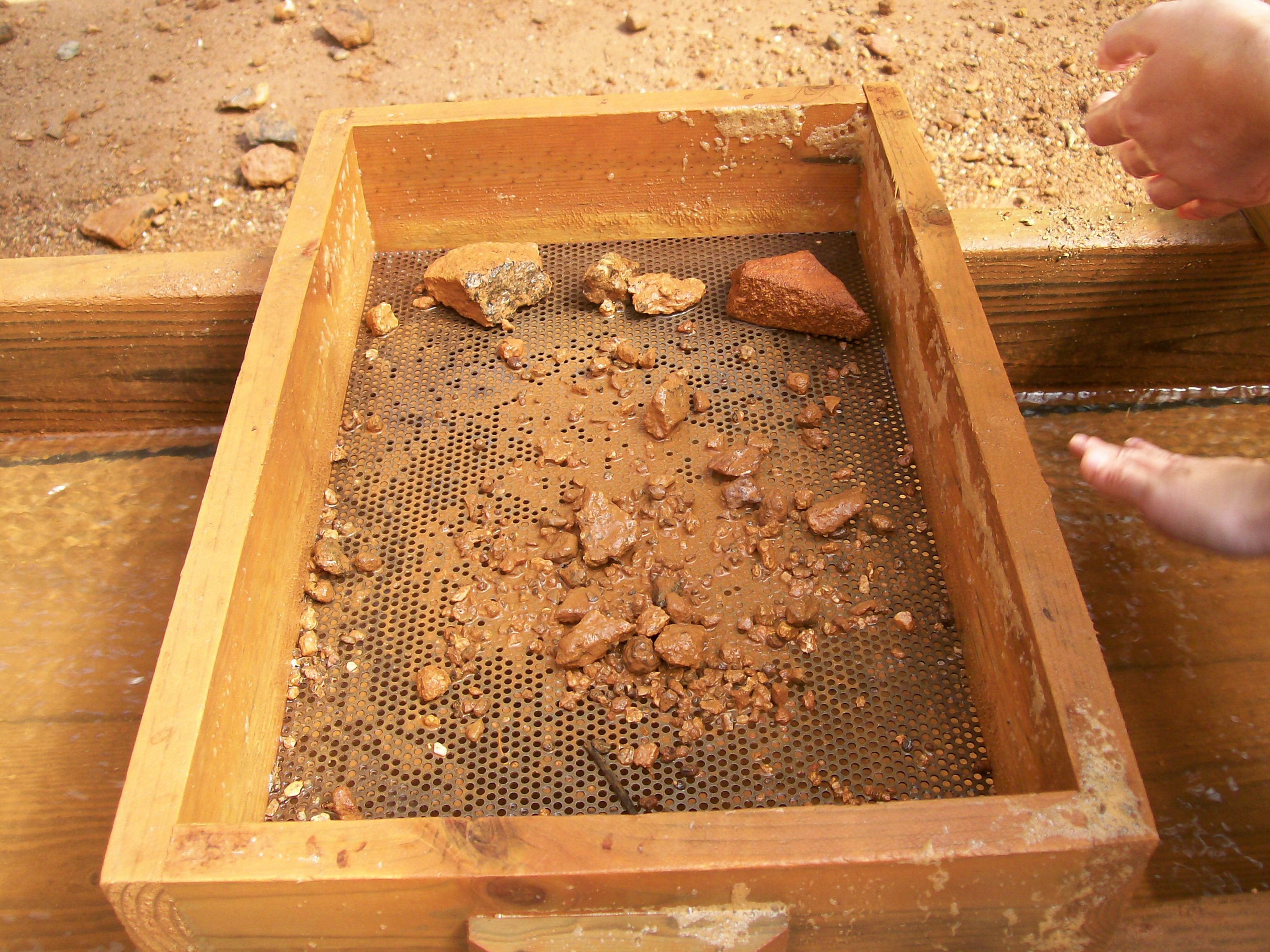 Some of best places to mine for gems in North Carolina are of the areas in and around the town of Franklin. This region is known as Gem Capital of the World because of the many different types of precious stones which are discovered there. When we visited, we chose to visit the Sheffield Mine to look for rubies and sapphires. We had a great time.
Some of best places to mine for gems in North Carolina are of the areas in and around the town of Franklin. This region is known as Gem Capital of the World because of the many different types of precious stones which are discovered there. When we visited, we chose to visit the Sheffield Mine to look for rubies and sapphires. We had a great time.
The Sheffield Mine is one of the oldest native mines in Macon County. In the 1870’s mining companies began actively mining for corundum found at Sheffield and the surrounding areas. Corundum is the second hardest mineral next to diamonds. Impure forms of corundum are used for producing abrasives, such as sandpaper. Pure forms provide the valuable gems. The pure corundum that appears red are rubies, while other colors are considered sapphires.
Because of the quality (and quantity) of the stones mined at Sheffield, it was once owned by famous Tiffany and Co. The Sheffield Mine is one of the extremely few places in the world where spectacular star rubies and sapphires are unearthed. These special gems, when cut in a cabochon shape, show an amazing star figure within the stone. Having the potential of finding one of these treasures is one of the main reasons we chose Sheffield.
The other major reason we decided on Sheffield was because our son, who was searching with us, is colorblind, and can’t see emeralds amongst the dirt. Emeralds are another fantastic gem found at other various mines in the region, but we thought we should stick with rubies and sapphires. Funnily enough, we first realized our son’s colorblindness when we were sluicing for ‘seeded’ gems quite a few years ago in Pennsylvania. After sifting through his bag of dirt at the flume, and picking all the colored gems out of it that he saw, he showed us his sifter saying he was finished. Scattered within his tray were all these ‘green emerald’ stones left. They looked like brown/greyish stones to him. Moral of the story is, a fun way to test if your child is colorblind or not, is to go gem mining. Lol.
The Sheffield Mine is open from the beginning of April to the end of October. The basic price for admission is $15 for most ages (15-60 years (10 all others)) and includes two native or ‘seeded’ buckets of dirt, a seat at the flume, and supplies needed to find the rubies and sapphires within the dirt.
Because the gems are found natural, they look different from the cut and polished stones most are familiar with seeing. Spotting them raw may take some training. Always standing nearby at the flume is a staff member who is willing to explain and demonstrate the techniques needed to sort through the buckets. They are also willing to answer (even after their full instructions), ‘Is this a ruby? What about this one?’….more than just a few times. Of course, we got there first thing in the morning, and at the end of the day, I am not so sure…
By removing as much dirt as possible using the flowing water in the flume, and then cupping the stones under the palms of our hands and rubbing them against the sifter bottom and each other, edges of valuable gems started to appear. What had been hidden for centuries was discovered! Red, purple, pink, and other colors peeked out from the encased grime that kept them secret for ages.
During a normal season, there are hundreds of large rubies and sapphires found at the Sheffield Mine by the public. No one knows which pile of dirt holds a potential ‘honker’ or ‘super honker’. But even if you don’t find any big ones, you will most certainly be able to walk away with a few small gems. Our family just loved the excitement and anticipation of trying to find the hidden treasures. I would recommend gem mining to anyone wanting to have some great family fun.
What I wouldn’t recommend, though, is going straight from the mines to the Biltmore Estate. I sort-of have to laugh at doing this. Mining is not the cleanest of adventures, and we weren’t thinking of how we might look after leaving the mine to go tour one of the finest homes in the States. Lol. It really didn’t matter to us, however. We still had a wonderful time.
We plan on going back to check out other locations to mine in the future. The presence of these beautiful gems, available to be found, is too much to dismiss! And if you decide to go, best of luck in finding some magnificent ones! Feel free to share a story of it here!


Pingback: A Journey - Page 1063
Sounds like a lot of fun, Jenny! Hopefully, you’ll find something of extreme value there some day. I have this friend of mine who is also “Red Green” Colorblind. They are only able to see about 10 percent of the actual color in the color spectrum. They can however see a wide variety of blues and yellows. For that reason, blue is always their favorite color. I’m guessing that your Father was red green colorblind too because that is how the gene gets passed on to the son. Females only. carry the gene in “recessive” form so are rarely effected by it.
Thanks Mark, we hope to do a lot more gem mining and gold panning in the future…..We enjoy searching for things… I would love to find the ‘Blue Pearl’:https://mysteriouswritings.com/the-blue-pearl/
And you would be correct; my dad is colorblind too; those troublesome red and greens.
awesome information Nate. You have helped inspire a future article entitled ‘Mysterious Stones’! Off to research more.
I used to be heavily into crystals back in the early 1990’s. I even bought some cut stones such as Amythest citrine, green tourmaline and Hessonite which I had faceted so that I could wear them on a chain. The one that I used to really want was yellow sapphire because I was into Hindu Astrogy, and Jupiter rules my Rising Sign (Sagitarius) in my Hindu Astrology chart. But that stone costs a fortune so I went with the hessonite. Actually,it was the green tourmaline that I liked the most. But just like Nate, something happened to those stones. Not sure if they were stolen or if I just misplaced them. But they served me well for the times, so at least I got some use out of them.
Hey Nate. Actually, in Hindu Astrology, certain types of Gemstones can be understood as representing antidotes for the afflictions of the planets in a person’s Chart. By antidotes, I mean that is believed that they can have beneficial effects on the mind. However each planet has it’s own particular type of gemstone which corresponds to the energy of the planet. For example, Yellow Sapphire corresponds to Jupiter, blue sapphire corresponds to Saturn, Emerald corresponds to Mercury, Red Coral corresponds to Mars, Diamond corresponds to Venus. Pearl corresponds to the Moon, and Ruby corresponds to the Sun.
However being that most of these gemstones are so expensive that their not really affordable, you can go with substitutes which are less expensive. For example, Red Garnet in place of Ruby or Green tourmaline in place of emerald or Amythist in place of Blue Sapphire or Hessonite in place of Yellow Sapphire.
The idea is that you can either wear the gemstone that represents the sign of your Rising Sign (first house) or Moon Sign and it can help to benefit the affairs of your life in some way. However, that has a lot more to do with gemstones which are cut, So when I said I had Sagitarius rising, that means Jupiter rules that sign, so I could use Yellow Sapphire to benefit me. But the size and weight of the cut gemstone is a big factor in determining how effective the gemstone is. And Substitutes tend to be inferior to the more expensive stones, but can still give good results.